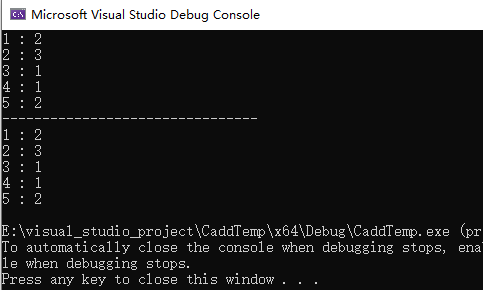1. c++ vector 每个元素加上一个特定值 (c++ vector add a constant value for each element)
https://stackoverflow.com/questions/4461446/stl-way-to-add-a-constant-value-to-a-stdvector
1 vector<int> x = {0, 30, 80, 100, 120, 150, 190, 220, 250};
2 //transform可以将函数应用到序列的元素上,bind2nd通过绑定其中一个参数把二元函数转换成一元函数
3 transform(x.begin(), x.end(), x.begin(), bind2nd(plus<int>(), 1));
4 //显示x的值
5 copy(x.begin(), x.end(), ostream_iterator<int>(cout, " "));
结果: x = {1 31 81 101 121 151 191 221 251}
2. c++判断vector中是否存在某个元素(c++ judge whether an element exists in the vector)
https://www.techiedelight.com/check-vector-contains-given-element-cpp/
1 #include <iostream>
2 #include <vector>
3 #include <algorithm>
4
5 int main()
6 {
7 std::vector<int> v = { 4, 7, 5, 2, 6, 9 };
8 int key = 6;
9
10 if (std::count(v.begin(), v.end(), key))
11 std::cout << "Element found";
12 else
13 std::cout << "Element not found";
14
15 return 0;
16 }
结果显示:Element found
3. c++ vector<int> 生成指定个数的顺序列表 (c++ generate a sequential vector<int> of special numbers)
https://stackoverflow.com/questions/17694579/use-stdfill-to-populate-vector-with-increasing-numbers
1 std::vector<int> seq(10);
2 // 定义在 numeric 头文件中的 iota() 函数模板会用连续的 T 类型值填充序列
3 std::iota(seq.begin(), seq.end(), 0);
结果: seq = {0, 1, 2, 3, 4, 5, 6, 7, 8, 9}
4. c++ 一条语句打印vector信息(c++ print out vector by one statement).
https://stackoverflow.com/questions/10750057/how-to-print-out-the-contents-of-a-vector
1 vector<int> x = {1, 2, 3, 4};
2 //istream_iterator用于从输入流中读取连续的元素
3 copy(x.begin(), x.end(), ostream_iterator<int>(cout, " "));
结果显示: 1 2 3 4
5. c++ 得到vector<int>中元素的最大值和最小值以及最大值和最小值的索引位置 (c++ get the maximum and minimum values of the elements in vector<int> and the index positions )
1 vector<int> row_y = { 502, 263, 684, 324, 979 };
2
3 // 最大值索引和最大值
4 int row_y_max_index = max_element(row_y.begin(), row_y.end()) - row_y.begin();
5 cout << "row_y_max_index = " << row_y_max_index << endl;
6 int row_y_max_value = *max_element(row_y.begin(), row_y.end());
7 cout << "row_y_max_value = " << row_y_max_value << endl;
8
9 // 最小值索引和最小值
10 int row_y_min_index = min_element(row_y.begin(), row_y.end()) - row_y.begin();
11 cout << "row_y_min_index = " << row_y_min_index << endl;
12 int row_y_min_value = *min_element(row_y.begin(), row_y.end());
13 cout << "row_y_min_value = " << row_y_min_value << endl;
结果返回:
row_y_max_index = 4
row_y_max_value = 979
row_y_min_index = 1
row_y_min_value = 263
6. c++ vector 相加两个vector (c++ append a vector to vector)
https://stackoverflow.com/questions/2551775/appending-a-vector-to-a-vector
1 vector<int> x = {0, 30, 80, 100, 120, 150, 190, 220, 250};
2 vector<int> y = {100};
3 y.insert(y.end(), x.begin(), x.end());
结果:y = {100, 0, 30, 80, 100, 120, 150, 190, 220, 250}
7. c++ 复制vector(c++ copy vector)
https://www.geeksforgeeks.org/ways-copy-vector-c/
1 vector<int> x = {0, 30, 80, 100, 120, 150, 190, 220, 250};
2 vector<int> y;
3 y.assign(x.begin(), x.end());
结果:y = {0, 30, 80, 100, 120, 150, 190, 220, 250}
8. c++ vector 根据给定索引删除元素(c++ vector delete element based on a given index)
https://iq.opengenus.org/ways-to-remove-elements-from-vector-cpp/
若想要删除第2个索引值和到第5个索引值,则可以使用下以语句:
1 vector<int> x = {0, 30, 80, 150, 120, 150, 30, 220, 80};
2 //remove(x.begin(), x.end(), 80);
3 x.erase(x.begin() + 2, x.begin() + 5 + 1);
结果: x = {0, 30, 30, 220, 80}
9. c++ 删除vector所有指定元素(c++ delete all specified elements in the vector)
https://www.techiedelight.com/erase-elements-vector-cpp/
1 vector<int> x = {0, 30, 150, 30, 220, 80};
2 //vector中的remove的作用是将等于value的元素放到vector的尾部,但并不减少vector的size
3 //vector中erase的作用是删除掉某个位置position或一段区域(begin, end)中的元素,减少其size
4 x.erase(remove(x.begin(), x.end(), 30), x.end());
结果: x = {0 150 220 80}
10. c++ 统计 vector 某个元素出现的次数 (C++ count the number of occurrences of an element in vector)
https://www.geeksforgeeks.org/std-count-cpp-stl/
1 vector<int> x = { 0, 3, 5, 6, 3, 2, 3 };
2 int n = count(x.begin(), x.end(), 3);
结果:n = 3
备注:如果想要把出现的数字和次数转换成map形式(如下图所示),可以看前本博客的几篇文章:c++ 统计 vector 每个元素出现的次数 (C++ count the number of occurrences of each element in vector)(2020.3.13)
